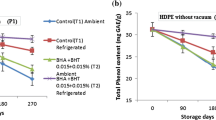Abstract
Coconut water and kernel are the edible portions of the coconut. A study was carried out to evaluate the physico-chemical characteristics, phytonutrients and stability of coconut water (CW), kernel (CK) at different stages of maturity and commercial coconut products (CCP). The moisture content of CW, CK and CCP were in the range of 95–97 g 100 g−1, 50–85 g 100 g−1 and 0.4–3 g 100 g−1 respectively. Fat content in CW was low (4–115 mg 100 g−1) whereas in kernel it was high (37–56 g 100 g−1). The CW was acidic in nature (pH 4.5–5.2). Ash content of CK decreased with maturity (1.0–1.5 %) whereas that of CW remained steady (0.3–0.4 g 100 g−1) with maturity. The total sugar content (3.9–4.6 g 100 g−1) and acidity (0.3–0.4 g 100 g−1) of CW did not change with maturity. The phenolics content increased in water (1.4–4.3 mg 100 g−1) and kernel with maturity (18.5–24.8 mg 100 g−1). The fatty acid composition of the oil extracted from the CK had increased saturated fatty acids (C12:0) (38–48 g 100 g−1) and decreased monounsaturated fatty acid (C18:1) (13–5 g 100 g−1) with maturity. The percentage of medium chain fatty acids increased with different stages of maturity (47–78 g 100 g−1). The CW and CK contained higher amount of phenolics (1.4–4.3 mg 100 g−1 and 18.5–24.8 mg 100 g−1 respectively) and total tocopherols of CK (0.14–0.59 mg 100 g−1) when compared to CCP. This study indicated that CW and CK could serve as valuable raw materials for the preparation of functional food supplement.
Similar content being viewed by others
References
Abdul HS, Zafar Iqbal M (2011) Chemical composition of meat (kernel) and nutwater of major coconut (Cocos nucifera) cultivars at coastal area of Pakistan. Pak J Bot 43(1):357–363
AOAC (2000) Official Method of Analysis. Association of Official Analytical Chemists, 17th edn. Gaithersburg, Maryland
AOCS Official methods of the American Oil Chemists Society (1997) AOCS method no. Ac 2–41. American Oil Chemists Society, Champaign
AOCS Official methods of the American Oil Chemists Society (1998) AOCS method no. Ca 5a–40, Cd 8–53. American Oil Chemists Society, Champaign
AOCS Official methods of the American Oil Chemists Society (2007) AOCS method no. Ce 8–89. American Oil Chemists Society, Champaign
Augustin S, Gary W (2000) Dietary intake and bioavailability of polyphenols. J Nutr 130:2073S–2085S
Banzon JA (1990) The coconut palm and its fruit. In: Banzon JA, Gonzalez ON, Leon SY, Sanchez PC (eds) Coconut as Food. Philippines Coconut Research and Development Foundation, Quezon City, pp 3–7
Bhatnagar AS, Prasanth Kumar PK, Hemavathy J, Gopala Krishna AG (2009) Fatty acid composition, oxidative stability and radical scavenging activity of vegetable oil blends with coconut oils. J Am Oil Chem Soc 86:991–999
Campos CF, Souza PEA, Coelho JV, Gloria MBA (1996) Chemical composition, enzyme activity and effect of enzyme inactivation on flavor quality of green coconut Water. J Food Proc Press 20:487–500
Chowdhury MGF, Rahman MM, Tariqul Islam AFM, Islam MS (2009) Processing and preservation of green coconut water. J Innov Dev Strateg 3(1):1–5
Codex Alimentarius (2003) Codex standard for named vegetable oils. Codex Stan 210:5–13
Darilyn CF, Tamara T, Troy MF, Narco T, Kathleen C (2000) The intravenous Use of coconut water. Am J Emerg Med 18:108–111
Dubios M, Gilles KA, Hamilton JK, Rebers PA, Fred S (1956) Colorimetric method for determination of sugars and related substances. Anal Chem 28(3):350–357
Jayalekshmy A, Arummaghan C, Narayanan S, Mathew AG (1986) Changes in the chemical composition of coconut water during maturation. J Food Sci Technol 23:203–207
Jean WHY, Liya G, Yan FN, Swee NT (2009) The chemical composition and biological properties of coconut (Cocos nucifera L.) water. Mol 14:5144–5164
Jose CJ, Andre G, Gavin W, Kayanne McCookand Rosa R (2004) Changes in chemical composition of coconut (Cocos nucifera) water during maturation of the fruit. J Sci Food Agric 84:1049–1052
Kapila NS, Dissanayake MSD (2008) Variation of phenolic content in coconut oil extracted by two conventional methods. Int J Food Sci Technol 43:597–602
Kiyasu JY, Bloom B, Chaikoff IL (1952) The portal transport of absorbed fatty acids. J Biol Chem 199:415–419
Michael F, Ivor D, Clare A (1997) Vitamin-E supplements and their effect on vitamin-E status in blood and genetic damage rate in peripheral blood lymphocytes. Carcinog 18(2):359–364
Njoku PC, Ohia CC (2007) Spectrophotometric estimation studies of mineral nutrient in three cocoyam cultivars. Pak J Nutr 6(6):616–619
Osawa T, Namiki M (1981) A novel type of antioxidant isolated from leaf wax of eucalyptus leaves. Agric Biol Chem 45:735–739
Rachel AR, Jean Louis KK, Alexia P, Jean N, Ernest K (2010) Physic chemical characteristics of kernel during fruit maturation of four coconut cultivars (Cocos nucifera L.). Afr J Biotechnol 9(14):2136–2144
Raghuramulu N, Nair KM, Kalyanasundram S (2003) A manual for laboratory techniques. National institute of Nutrition, Hyderabad
Raissa ET, Felicito MR, Rita PL, Marni EC (2007) Total free sugars, oil and total phenolics content of stored coconut (Cocos nucifera L.) water. Philipp J Sci 136(2):103–108
Raja Rajan RJ, Prasanth Kumar PK, Gopala Krishna AG (2010) Tocopherols and phytosterol contents of coconut oil blends prepared for coconut oil consumers and non-coconut oil consumers. Indian Coconut J 3(4):16–20
Shaw M, Srivastava BIS (1963) Purine like substances from coconut endosperm and their effect on senescence in excised cereal leaves. Plant Physiol 38:528–531
Steele RGD, Torrie JH (1980) Principles and procedures of statistics. Mc Graw- Hill, New York
Acknowledgments
Authors are thankful to Prof. Ram Rajasekharan, Director CSIR-CFTRI, Mysore for providing infra structural facilities and The Coconut Development Board, Kochi, for funding the project.
Author information
Authors and Affiliations
Corresponding author
Rights and permissions
About this article
Cite this article
Appaiah, P., Sunil, L., Kumar, P.K.P. et al. Physico-chemical characteristics and stability aspects of coconut water and kernel at different stages of maturity. J Food Sci Technol 52, 5196–5203 (2015). https://doi.org/10.1007/s13197-014-1559-4
Revised:
Accepted:
Published:
Issue Date:
DOI: https://doi.org/10.1007/s13197-014-1559-4




